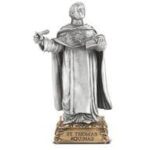
St. Cajetan
Saint Cajetan
St. Cajetan – Patron Saint of the Unemployed and Workers
When they lived: St. Cajetan, also known as St. Gaetano dei Conti di Tiene, was born on October 1, 1480, and he passed away on August 7, 1547.
Where they lived: St. Cajetan lived primarily in Italy, with significant periods spent in the cities of Vicenza, Venice, and Naples.
Notable world events during the time of their life:
- Age of Exploration (late 15th to early 17th centuries): During St. Cajetan’s lifetime, European explorers like Christopher Columbus, Vasco da Gama, and Ferdinand Magellan were making groundbreaking voyages, discovering new lands, and establishing new trade routes. This era marked a significant expansion of global knowledge and interconnectedness.
- Protestant Reformation (early 16th century): The Reformation was a time of religious upheaval, initiated by figures like Martin Luther and John Calvin, challenging the authority of the Roman Catholic Church. This movement had a profound impact on Christianity, leading to the formation of various Protestant denominations and inspiring religious reforms within the Catholic Church as well.
- Renaissance (14th to 17th centuries): St. Cajetan lived during the height of the Renaissance, a period of cultural rebirth characterized by a flourishing of art, literature, and scientific inquiry. Notable figures like Leonardo da Vinci, Michelangelo, and Copernicus were shaping the world with their contributions, elevating human knowledge and creativity.
- Italian Wars (1494-1559): The Italian Wars were a series of conflicts involving major European powers seeking control over Italian territories. These wars had a lasting impact on the political and cultural landscape of Italy and neighboring regions.
- Printing Revolution (15th century): The advent of the printing press during St. Cajetan’s lifetime revolutionized communication and disseminated knowledge more widely. It played a crucial role in the spread of religious ideas, scientific discoveries, and cultural exchange.
Their patronage: St. Cajetan is revered as the patron saint of the unemployed, job seekers, and workers. He dedicated his life to serving the poor and the sick and founded the Theatines, a religious order known for their commitment to poverty, humility, and reform within the Catholic Church. His compassionate and selfless nature continues to inspire those in need and those seeking meaningful employment or assistance in times of difficulty.
And so His Life Took a Different turn.
The youngest of three brothers, Gaetano da Conti di Thiene, was born into nobility of first rank on October 1, 11480, in Vicenza, Italy. His father was Count Gasper, Lord of Thiene, and his mother was Maria Porta, a devout woman.
By every standard of that era, Cajetan was a silver-spoon boy. Sadly, his father died when Cajetan was only two years old. His mother took it upon herself to see that Cajetan received an excellent spiritual and physical education with all purity.
The Lawyer
Cajetan got an early start, and he ran with it. At the age of 24, in 1504, he graduated with a doctorate degree in Civil law and Canon law from the University of Padua.
In 1506 he was invited to Rome by Pope Julius I to work with him as a diplomat. He assisted at the 5th Lateran Council and reconciled the Republic of Venice with the Pope’s side.
When Pope Julius 11 passed on in 1513. Cajetan resigned from his position to join the priesthood.
The Call
You have made us for yourself, O Lord, and our heart is restless until it rests in you. St. Augustine of Hippo
Those words of Augustine of Hippo were very accurate for Cajetan. His heart burned with a higher devotion he had never known before. In 1513, he studied to become a priest, leaving behind what seemed like a promising career.
On September 30, 1516, Cajetan was ordained a priest. Soon after he became a priest, his mother became sick, and he went back to his hometown in Italy in 1518.
After his mother’s death, he set up a hospital for the incurables in 1522 at Vincenza. He was dedicated to caring for the sick, the poor, and the sad in society.
Cajetan and a few like-minded priests came together to form a new congregation in 1523. The congregation was known as the Order of the Theatine. The title was taken from one of the co-founders, Giovanni Pietro Caraffa, bishop of Theate, who later became Pope Paul IV.
Mission to Rescue the Church
Upholding the vows of charity, chastity, and obedience, Cajetan and his companions were scandalized by the life of the clergy (Church) in Rome. The Church of God and its leadership were in terrible shape.
People were hungry for bread and spiritual nourishment, and the clergy, whose duty it was to feed the laity with the words of God, were lost in immorality and acquiring wealth.
The leadership of the country was no different than the church, which was complacent.
Many were hungry, and morality was at an all-time low in Rome. The church needed to be rescued from itself, but who would call the cat?
Cajetan returned to Rome, and together with the few morally conscious priests and the Theatines, they embarked on reformation within the church. They took off their beautiful vests and put on poor robes, and they identified with the poor and worn-out of society.
Cajetan hungered to save souls going astray. They led by example. He practiced moral living, taught religious studies, preached the truth, spoke reason to the nobles, challenged the status quo, and above all, tendered to the sick and needy. Never neglecting any.
Cajetan and his group persisted in the face of open opposition from the laity and clergy, who didn’t want the reformation. Their lives were the opposite of how many priests lived then.
His practical life and example won many, and holy life gradually crept back into the church, even though the process was slow.
Joy in Suffering
In 1527, the Theatines were sacked by Spanish soldiers during the sack of Rome. They fled to Venice. Cajetan, in particular, was imprisoned and tortured by the soldiers before he was released to join his order.
In Venice, Cajetan continued caring for the sick and needy. He also built a hospital for the incurables.

The Pope sent Cajetan to Naples in 1533. In Naples, he founded another oratory (congregation). He also established a nonprofit bank designed to protect the poor from borrowing money at exorbitant rates. That bank is now the Bank of Naples.
Worn out from labor, Cajetan became sick. When doctors advised him to be transferred to a bed rather than the board he sleeps on, he refused. He said, “My savior died on the cross; let me die on the wood at least.”
He died on August 7, 1547.
5 Interesting Facts About Saint Cajetan
- A man of great courage, he showed the light when the church was in
dark place. - Do you have any concerns about the church? St. Cajetan has shown
that fighting for the reformation of the church is better than
fighting against the church. - Are you unemployed and worried? Call on St. Cajetan. He’s the patron.
saint of the unemployed, bankers, gamblers, workers, and job
seekers. He’s been there before. - A man of empathy. He emptied himself to care for the needy, and the
sick with all his nobility afforded him. - What better way to be joyful in suffering? He offered all his
sufferings for the conversion of souls.
Prayer to Saint Cajetan
Glorious St. Cajetan, acclaimed by all people to be the Father of Providence because you provide miraculous aid to all who come to you in need, I stand here before you today, asking that you present to the Lord the requests that I confidently deposit in your hands. May these graces that I now request help me to always see the Kingdom of God and His righteousness, knowing that God, who dresses with beauty the flowers of the field and abundantly feeds the birds of the sky, will give me all other things. Amen.



